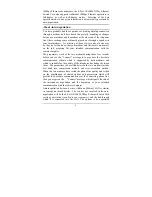
2
10Mbps Ethernet environments, the 4-Port 10/100M NWay Ethernet
Switch Card also supports traditional 10Mbps Ethernet operation, in
full-duplex as well as half-duplex modes. Selection of the best
operation mode in any given installation is automatically governed by
auto-negotiation.
About Auto-negotiation
You have probably had the experience of making a dialup connection
through a modem, and have heard the gravelly
−
sounding exchanges
between your modem and the modem at the other end of the telephone
line (these exchanges are ordinarily played out through a speaker in
your local modem). As irritating as those few seconds of noise may
be, they do let you know that your modem and the remote modem are
on the job, preparing for your intended communication with the
remote computer.
The preparatory work of the two modems during those few seconds
before you see the “Connect” message is to
negotiate
the best data
communication scheme which is supported by both modems, and
which is suitable for the quality of the telephone line linkage between
them. The parameters to be settled between the two modems include
best baud rate, compression method, and error correction method.
When the two modems have tested the phone-line quality and settled
on the combination of shared options and parameters which will
provide the best data communication over the connecting phone line,
then you are given the
”Connect” message which signals the end of
the intermodem negotiation and the beginning of your intended
communication with the remote computer.
Auto-negotiation between devices within an Ethernet LAN is similar
in concept, but much briefer. The two devices involved in the auto-
negotiation will be the 4-Port 10/100M NWay Ethernet Switch Card
serving your station (
installed in your computer
), and the hub through
which it is connected into the LAN. The options to be negotiated
Содержание TE100-S4PCI
Страница 1: ...TE100 S4PCI 4 Port 10 100M NWay Ethernet Switch Card User s Guide...
Страница 4: ......
Страница 14: ......

































